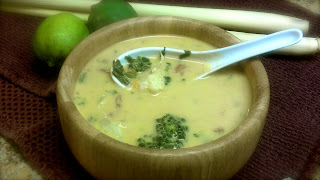I used to love the Tom Kha Gai soup you get in Thai restaurants. It always felt nourishing, reviving, yet light all at the same time with the sour from the limes balanced with the cream of the coconut. It's basically the Thai version of our American 'chicken soup' or, in other words, the quintessential "cure-all-comfort" soup for Thailand. "Tom" means soup, "Kha" means galangal (a root vegetable), and "Gai" means chicken. Since we are making this vegan, it simply becomes Tom Kha Soup sans the chicken or Gai. I used to make this soup with fish sauce, as the traditional recipe calls for it, but, as with many of my staple foods, I had to alter the recipe once I became vegetarian. I was worried about this one, thinking the fish sauce was essential to such a traditional dish. Well, it turns out it's really the fresh lime, cilantro, and coconut milk that really add the most to the final flavor outcome.
Soy sauce works in a pinch as a great replacement to the fish sauce and in my opinion, I couldn't even tell the difference. The best part about this soup is that it's easy, quick, and tastes just like restaurant quality. Great for a rainy night staying at home watching movies. You could pair this with an easy peanut noodle salad for a quick Thai-at-home meal. Most Asian markets will carry these ingredients because they are so commonly used in Thai cooking. I've never had a problem finding fresh or dried galangal, even though I had never heard of it before making this soup. It looks like ginger, only whiter, but it tastes nothing like it. Galangal is a surprisingly mellow and earthy flavor with a slight hint of asian pear flavor.
Oh, if you can, be sure to get Chaokoh coconut milk. Many years ago when I first made this soup, the owner of my local Asian market told me to get this specific brand upon hearing I was making Tom Kha. I've been using it ever since and after getting a different kind once, I realized he was right...this one is THE best.
Oh, if you can, be sure to get Chaokoh coconut milk. Many years ago when I first made this soup, the owner of my local Asian market told me to get this specific brand upon hearing I was making Tom Kha. I've been using it ever since and after getting a different kind once, I realized he was right...this one is THE best.
Vegan Tom Kha Soup (Serves 4)
Ingredients:
1 quart (4 cups) vegetable broth, or a standard 32 oz package of broth
2 cans good coconut milk, like Chaokoh brand (pictured above)
3 stalks lemongrass, chopped and bruised*
5-6 kaffir lime leaves, fresh or dried
6 slices dried or fresh galangal root
1-2 limes, always good to have extra to get it to your liking!
1 bunch cilantro
1 tomato, chopped very fine
1/4 cup soy sauce
2 tsp sea salt
1 tbsp honey (or agave or cane sugar)
2 tsp chili paste, such as Sambal Olek (Sriracha or hot sauce works in a pinch)
Assorted vegetables (I used baby broccoli, cauliflower, and yams. Others like mushrooms, baby corn, red bell pepper, etc).
Directions:
- In a big soup pot over high heat, add vegetable broth and bring to a boil.
- While broth is heating up, cut off the white bottoms of the lemongrass (~3 inches of material per stalk) and chop into one inch pieces. Using the flat side of your knife, press down and bruise/smash the lemongrass stalks*. You will hear them crack beneath the weight and you will smell the aroma of lemongrass signifying you have released the potent juices.
- Add lemongrass, kaffir lime leaves, and galangal to the boiling broth. Cover and let simmer for 5 minutes on a boil to release the aromatics into the broth.
- Add soy sauce, coconut milk, tomato, and salt and, if using, add diced yams since they need the longest to cook. Cover and let soup return to a simmer.
- When soup is back up to a simmer, add the other vegetables, the chili paste, and the honey and stir with a wooden spoon.
- When vegetables are tender to your liking (~10 minutes), add chopped cilantro and the juice of one lime and taste for levels of salt, sweet, hot, and sour. Adjust as necessary.
- To serve, ladle soup so as to avoid putting the inedibles like galangal, lemongrass, and kaffir leaves.


Comments
Post a Comment